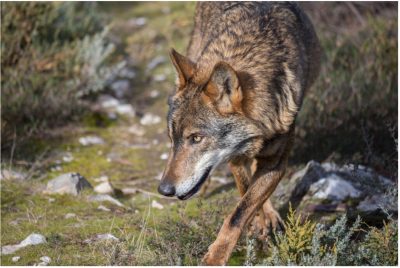Sustainability Stories: Rewilding
Sustainability Stories
Welcome back to Sustainability Stories. Sustainability is a hot topic right now, and for good reason. As it appears we are powering towards an uncertain future, more and more people are looking for a way to look forward in a positive light, and to see the changes they could make that might just make a difference to the future. Join me for the latest edition of Sustainability Stories.
We’re going to focus on a good news story, there is so much doom and gloom surrounding sustainability and the climate crisis, we need to balance that out and remind ourselves of the positive.
Wildlife is making a comeback!
After being driven to near extinction, the grey wolf is one species amongst 50 others making a comeback in Europe. The return of wolves on the European continent has been documented in a report by Rewilding Europe, a Netherlands-based non-profit organization that aims to restore wildlife in the region.

Wolves are recovering all across Europe and readily recolonize areas where humans allow their presence.
(Daniel Allen)
The European Wildlife Comeback report found that populations of some European wildlife species have grown in size and geographical range over the last 40 to 50 years. Compiled by ZSL (Zoological Society of London), BirdLife International and the European Bird Census Council, the report looks at 50 European wildlife species.
With wildlife species disappearing at an alarming rate, the report shows that wildlife will return given space to recover and aims to live alongside harmoniously. It demonstrates measures such as better legal protection, enlarging and connecting protected areas, dedicated species recovery work, and improving habitats are effective. It shows the importance of continuing to reduce pressures, such as habitat loss and hunting.
Grey wolves are recovering across Europe and now readily recolonize areas where humans allow their presence. The European Union is encouraging human-wolf coexistence by offering funding for prevention measures (fences and livestock dogs), alongside full compensation to farmers for livestock lost to wolf predation.

Coexistence measures like livestock guarding dogs can support acceptance and therewith further wildlife recovery.
(Ricardo Ferreira – Blue Nomads)
As usual with Sustainability Stories, to keep this story in my readers’ minds, I will finish with a short story.
———————————————————————
The leaves fold and crunch beneath my boots as I set one foot in front of the other, venturing further into the misty forest. Snowflakes fall and melt against my cheeks, the warm air from my breath forming miniature clouds in front of my face. The robins dart around my feet and flit through the air and trees, their chirps adding to the birdsong that is part of the forest chorus. Rustling, scurrying, the sounds of the small creatures that call the forest floor their home, they duck in and out of their hiding holes, always watching.
Being born in the countryside of Norway, I have been surrounded by wildlands since birth. Nature is a part of me, and I a part of it. I feel comfortable in nature, surrounded by the trees and birdsong, and the pawprints that tracked my progress through the forest.
I did not fear these pawprints, for they were the marks of my protectors, my guardians. Wherever I ventured, I knew I was guarded against any evil that may follow me.
I hear the heavy paw pads against the ground, thud, thud. The leaves crunch and crackle under their weight, twigs snapping and branches brushing through their fur. I know where they will emerge, I can track their movements, listening to their motions, seeing the slight rustle of the bushes giving away their position.
They appear as one unit, three of them separate beings yet they move as one. From the undergrowth in front of me I saw the paws first. One paw pushes through the leaves and branches, followed by the other, and then you cannot help but stare into the eyes. Those bright, blue, icy eyes. How can there be so much meaning and soul conveyed through one pair of eyes? Then the second wolf emerges from the forest, followed shortly by the third.
One foot in front of the other, I continue my path onwards.
As I move forward, one by one yet together, the three wolves join me, walking shoulder to shoulder, wherever we may go.
I curl my hand into the leader’s fur, it’s coarse yet soft and comforting. His coat the colour of the morning dawn on the icy mountaintop. He looks down at me and lowers onto his haunches. I take the invitation and swing my leg across his wide frame, settling into the crook where his neck meets his back. The other two wolves assume their position on either side, ever-watchful guardians as we venture further into the snowy forest.
Continuing the patrol through the forest, we are always listening for sounds of despair or danger. Whilst not many would dare to show aggression towards our guardian pack, there is one being that all creatures of the forest fear: humankind. Ever unpredictable, yet always pushing their boundaries further and further into the forest.
Over the years we have found many of their human-made traps, designed to pin us in pain before they come to finish the poor creature off, their pelt or hide to be sold and made into a coat.
Moving further through the forest we find evidence of their presence, a cigarette butt carelessly discarded, no thought to the risk of forest fire, plastic wrappers strewn in their wake, and then the worst of it: acres of torn down trees, turned into their logging farms, guarded by poachers with rifles, waiting for their chance to take a prize.
Hackles raised, lips back and teeth bared, the wolves display their anger at this sight. All they can do is herd the forest animals away from danger, fulfilling their guardian roles. They cannot do anything to stop the violence, lest they become victims alongside. But I can.
Stepping back into my human life, I am just one among many like me who wish for the environment to be saved. Recently we banded together and stopped a planned major hunt of 25 wolves, four packs, within the designated conservation area. There are only thought to be 80 wolves living in Norway, the slaughter would be a devastation to the population efforts.
This experience proves, if everyone comes together, the guardians can continue to protect the creatures of the forest, and we can live alongside in harmony.
———————————————————————
References:
Bird Life International (2022). Homepage. Bird Life International.
Browne E. (2022). After Being Driven to Near-Extinction, Wolves Are Making a Comeback.
Newsweek.
https://www.newsweek.com/gray-wolf-populations-increasing-recovering-europe-us-1746579
Elton C. (2022). Wolves, bears and bison: 50 species make ‘spectacular comeback’ in Europe.
Euronews.green.
European Bird Census Council (2022). Homepage. European Bird Census Council.
Hall S. (2022). Wolves and brown bear numbers are up in Europe, a new report shows. World
Economic Forum.
Horton H. (2022). Norway’s wolves ‘saved for this year’ as animal rights groups fight cull. The
Guardian.
Rewilding Europe (2022a). Wildlife Comeback Report 2022. Rewilding Europe.
https://rewildingeurope.com/wildlife-comeback-report-2022/
Rewilding Europe (2022c). Rewilding Europe. Rewilding Europe.
Rewilding Europe (2022b). European wildlife comeback: new report shows wildlife will return
if we give it space to recover. Rewilding Europe.
Weston P. (2022). Wolves and brown bears among wildlife making ‘exciting’ comeback in
Europe. The Guardian.
ZSL (2022). Homepage. ZSL.
